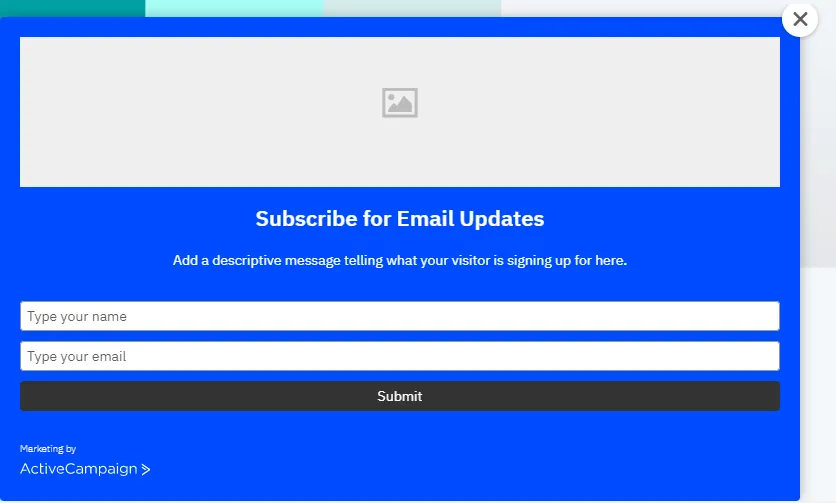Building Email Lists with Effective Popup Strategies
Building a robust email list is crucial for business growth and customer engagement in the digital marketing landscape. One of the most effective ways to grow your email list is through email popups. This strategy, when executed correctly, can significantly increase your subscriber base.
Email popups, which can request additional information such as visitors' phone numbers, gender, and content preferences, typically convert 3.8% of visitors on average. However, top-performing campaigns can achieve conversion rates as high as 23.6%. Email popups featuring just one signup field tend to be more effective, converting at an average rate of 4.3%, as they simplify the subscription process.
This article will delve into the nuances of crafting effective popup strategies, ensuring your efforts lead to tangible results.

Understanding Email Popups
An email popup is a form that appears on a website, prompting visitors to subscribe to a newsletter, receive updates, or get access to exclusive content. While some users find popups intrusive, their effectiveness in capturing leads cannot be ignored. The key to success lies in designing popups that are not only eye-catching but also provide genuine value to the visitor.
The Importance of Email Popups
Email popups are essential because they target visitors already interested in your content. You can convert these visitors into subscribers by presenting a compelling offer or incentive. This method is more effective than traditional static forms because popups grab attention and prompt immediate action.
Strategies for Effective Email Popups
To ensure your email popups are adequate, consider several factors, from design to timing and content. Below are key strategies to help you create popups that convert.
1. Crafting Compelling Content
The content of your popup is crucial. It should be clear, concise, and compelling. Highlight the benefits of subscribing, such as exclusive content, discounts, or early access to products. Use a strong call-to-action (CTA) that encourages immediate action. For example, "Join now and get 20% off your first purchase" is more enticing than a generic "Subscribe to our newsletter".

2. Designing Attractive Popups
Design plays a pivotal role in the effectiveness of your email popups. They should be visually appealing and align with your brand’s aesthetics. Use contrasting colors for the CTA button to make it stand out. Ensure the popup is not too cluttered; simplicity often leads to a better user experience and higher conversion rates.
3. Timing and Triggers
The timing of your popup can significantly affect its success. Displaying a popup too soon might annoy visitors while showing it too late might miss the opportunity to capture their interest. Use triggers such as exit-intent, scroll percentage, or time spent on the page to display your popup at the right moment. For instance, an exit-intent popup can capture visitors about to leave your site, offering them a last chance to subscribe.
4. Offering Incentives
People are more likely to subscribe if they receive something in return. Offer incentives like discounts, free trials, eBooks, or exclusive access to content. Ensure the incentive is relevant to your audience and valuable enough to encourage them to subscribe.
5. Optimizing for Mobile
With significant web traffic coming from mobile devices, your popups must be mobile-friendly. Ensure they are responsive and do not hinder the mobile user experience. Mobile popups should be easy to close and not cover the entire screen.

Implementing Popup Strategies: A Step-by-Step Guide
To effectively implement email popup strategies, follow this step-by-step guide:
- Identify your goals. Determine what you want to achieve with your popups. Is it to increase newsletter subscriptions, promote a new product, or gather feedback?
- Choose the right tool. Select a popup builder tool that offers customization options and integrates well with your email marketing platform and email delivery service provider. Tools like OptinMonster, Sumo, and Hello Bar are popular choices.
- Design your popup. Create a visually appealing design that aligns with your brand. Ensure the message is clear, and the CTA button stands out.
- Set triggers and timing. Configure when and where the website popup will appear on your site. Experiment with triggers like exit intent, time on page, or scroll percentage to find what works best.
- Conduct A/B testing. Test different versions of your popup to see which one performs better. Experiment with variations in design, copy, and incentives.
- Analyze and optimize. Review the performance of your popups regularly. Use analytics to track conversion rates and make necessary adjustments to improve effectiveness.
Best Practices for Email Popups
Personalization
Personalized popups can significantly improve conversion rates. Use data like user behavior, location, and previous interactions to create tailored messages. For example, a returning visitor could see a popup offering a special discount for loyal customers.
Clear and Concise Messaging
Your popup message should be straightforward to understand. Avoid jargon and ensure the benefits of subscribing are immediately apparent. A concise message with a strong CTA is more likely to convert visitors.
Testing and Iteration
Continual testing and iteration are crucial to optimizing your email popups. Use A/B testing to compare popup elements, such as headlines, CTAs, and designs. This data-driven approach helps refine your strategy for better results.
Respect the User Experience
While popups are effective, it’s essential to respect the user experience. Ensure your popups are easy to close and do not appear too frequently, which can frustrate visitors. Providing value and respecting user preferences will lead to higher conversion rates and a positive brand impression.

Conclusion
When implemented effectively, email popups can be a powerful tool in building your email list. You can create popups that convert visitors into subscribers by focusing on compelling content, attractive design, proper timing, and offering valuable incentives. Remember to continually test and optimize your strategies to achieve the best results. With these practices, you can enhance your email marketing efforts and foster stronger customer relationships.